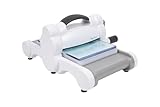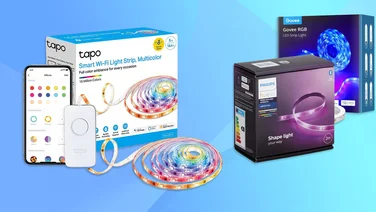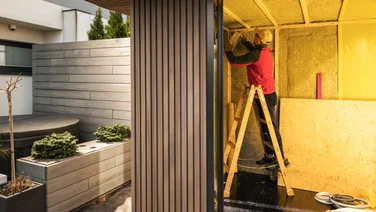To help us provide you with free impartial advice, we may earn a commission if you buy through links on our site. Learn more
- Best die cutting machines: At a glance
- How to choose the best die cutting machine for you
- The best die cutting machines to buy in 2023
- 1. Cricut Joy: The best digital cutting machine for beginners and small projects
- 2. Sizzix Big Shot: The best manual die cutter
- 3. Cricut Maker 3: The best top-of-the-range Cricut machine
- 4. Cricut Explore 3: The best all-round digital die cutting machine
- 5. Crafter’s Companion Gemini: The best electric die cutter

Whether you’re a keen beginner or experienced creative type, finding the best Cricuts and die cutting machines for your craft corner is guaranteed to be hugely rewarding. Both manual and digital cutting machines are able to cut a range of materials with expert precision, but they’re not only for cutting out shapes and stickers. Depending on the machine, some can engrave, emboss, add foil transfers and even write envelopes for you.
The list of projects you can embark on is truly endless. Die cutters allow you to make your own greetings cards, labels, keyrings, ornaments, wall transfers, gift boxes, jewellery or sticker sheets. By far and away one of the most popular projects at the moment is personalising items – adding names, slogans or images to a variety of items using either permanent vinyl or heat-transfer vinyl.
If you’ve never used a die cutting machine before, our buying guide will tell you everything you need to know. Below this, you’ll find our roundup of the best Cricut and die cutting machines to buy right now.
Best die cutting machines: At a glance
- Best all-round digital cutting machine | Cricut Explore 3
- Best electronic die cutter | Crafter’s Companion Gemini Die Cutting Machine
- Best top-of-the-range digital cutting machine | Cricut Maker 3
How to choose the best die cutting machine for you
What is a die cutting machine?
In their most basic form, diecutters work by pushing “dies” – shaped metal outlines, like stamps with raised edges – down onto paper or fabric, slicing the desired shape out cleanly. Most die cutters can also emboss, where a pattern or shape is pushed into a piece of card, leaving an impression on the material instead.
You can usually find universal dies and embossing folders (stamps) on any good craft supply website, with thousands of different themes and styles available.
READ NEXT: The best travel iron to buy
What are the key differences between cutting machines?
Digital cutting machines are currently taking the crafting world by storm, with Cricut-branded machines emerging as the must-have bit of creative kit. These smart machines use the online Cricut Design Space software to cut, emboss, score, draw and foil your designs on and into a huge variety of materials.
The most powerful Cricut machines can cut through wood and leather, while the smaller versions are perfect for cutting intricate shapes from vinyl or card. Because of their incredibly precise cut depth control, they can also perform “kiss cuts”, meaning you can cut out sticker sheets and labels, without cutting through the backing sheet.
Traditional die cutters are much simpler and easier to use and don’t need to be connected to a computer or any software. Most classic die cutters don’t even require a power source and use a manual hand crank to perform cuts. The ones that do require power feed materials through automatically.
What is the Cricut Design Space?
Cricuts are run through a bespoke piece of software called the Cricut Design Space. Available for PC, Mac, iOS and Android, this software enables you to put together your designs and interact with your machine. Here, you can tell it what to cut, draw, score and more. It also includes a library of pre-made projects and designs that you can immediately send to your machine.
The software itself is free, and you don’t need a Cricut to use it, meaning you can play around with Design Space to see how it works before you commit to buying anything. A good selection of free-to-use shapes, fonts and images is included, but for a monthly fee you can sign up to Cricut Access, which gives you access to its library of thousands of additional designs. Alternatively, you can pay per item as you go.
Are die cutters and digital cutting machines easy to use?
There’s definitely a knack to using even the simplest die cutter, and a quick read through the user guide is always going to be worth your while to ensure you don’t damage any part of the cutting plate or waste any material. Both of the manual die cutters we’ve included in our roundup come with excellent instructions and are a dream to use, even for complete beginners.
Depending on the type of project you’re working on, using a digital cutting machine can be a little tricker to get comfortable with. If you’re using a Cricut, the Design Space software is good at teaching as you go, telling you in what order to load mats and materials, and prompting tool changes as required. The huge and welcoming Cricut communities on Facebook and Instagram are also an absolute goldmine of advice and support tips.
Be prepared to put plenty of research time in to get the most out of your machines, though, and accept that there will be some experimenting required.
The best die cutting machines to buy in 2023
1. Cricut Joy: The best digital cutting machine for beginners and small projects

Price: £140 | Buy now from John Lewis
You might assume the smallest and cheapest Cricut is underwhelming compared to its beefier siblings, but straight out of the box the Joy feels like its own perfect little machine. It’s small enough that it can easily sit in the corner of a desk or bookshelf and connects to your tablet or computer via Bluetooth, meaning there’s no fiddly cable to deal with. As a result, it’s much quicker and easier to set up for first-time users.
Compared to the Maker and Explore 3, it might seem a little limited in what it can do. It’s not able to handle any thick materials such as wood and doesn’t have as many different blade types. The cut area is also a lot narrower at only 10.8cm, but it can still cut up to 42in (1.2m) in length for single continuous shapes, and up to 236in (6m) for repeated designs.
Instead of it simply being a cheaper, lighter version of the more premium models, the Joy has its own unique features and specialities. It’s the perfect machine for making greeting cards, for example. The Joy’s clever card mat is designed to perfectly hold pre-folded blank cards while it cuts, and draws beautifully intricate designs on the front. We made a large handful of cards in only 30 minutes – some with metallic inserts, some drawn by the machine itself using the Cricut pens, and others using the very nifty foil transfer tool. It was simple, incredibly good fun and very addictive.
If you’re completely new to digital cutting and crafting, the Cricut Joy is the perfect place to start.
Key specs – Type: Digital cutting machine; Dimensions: 10.7 x 13.7 x 21.4cm; Functions: Cutting, drawing, foil transferring; Suitable materials: Paper, card, vinyl, sticker paper, Cricut Joy Smart Materials; Maximum material size: 10.8cm x 1.2m for single cut, 6m for repeated designs
2. Sizzix Big Shot: The best manual die cutter

Price: £54 | Buy now from Amazon
Despite being the most entry-level machine on the list, the Big Shot from Sizzix has long been regarded as the absolute gold standard in die cutters, and not without good reason. These solid and reliable bits of kit have been a paper crafter’s best friend for years. Needing no cables, no design software and no fiddly tool changeovers, this 100% manual die cutter is as simple as it gets.
The clever platform that you load materials onto also doubles as the instruction manual, explaining which order to layer your die stamps and materials depending on their thickness and the specific die type.
We tested the Big Shot with everything from paper to thick felt, and were able to achieve a clean cut with every die. Compared to a digital cutting machine, the process is much slower, but when you bear in mind the cost difference and how simple the setup is, the merits of a manual die cutter are clear.
While the Big Shot is very reasonably priced, it’s worth mentioning that dies can be expensive. Unlike the near infinite supply of shapes and letters available on a digital platform, your choices are limited to what you can find in shops with a manual machine such as this. What’s more, as the Big Shot is entirely manual, it does require quite a bit of elbow grease, especially when cutting thicker materials.
For those with dodgy wrists or shoulders, it may be worth splashing out a little more on an electronic die cutter; otherwise, this is a great budget buy.
Key specs – Type: Manual die cutting machine; Dimensions: 42.1 x 29.46 x 23.11cm; Functions: Cutting, embossing; Suitable materials: Paper, cardstock, fabric, leather, sheet magnet, vinyl; Maximum material size: 15 x 21cm
3. Cricut Maker 3: The best top-of-the-range Cricut machine

Price: £400 | Buy now from John Lewis
This is the third iteration of Cricut’s premium model, the Maker, and it’s quite something. Lightning quick, incredibly powerful and able to cut through more than 300 different materials, the Maker 3 is undoubtedly worth its premium price tag.
Compared to its predecessor, the Maker 2, this machine cuts up to twice as fast. We ran plenty of test cuts on vinyl and sticker paper, and the Maker 3 was able to cut a series of large, complex shapes in just over a minute. The new “smart materials” are an absolute dream to use, too. Available as vinyl, iron-on and sticker cardstock, these materials can now be fed straight into the machine, instead of being placed on the cutting mat, saving even more time.
Another key upgrade is the new total cut length. Whereas previous models could only cut up to a maximum of 24in, the Maker 3 can perform cuts using Smart Materials of up to a remarkable 144in (3.7m), making it ideal for producing large wall decals and decorations.
Not only can it cut paper, cardstock and vinyl, but with the right attachments it can cut through soft fabric, leather and even wood. It can also engrave, emboss, score and draw on a huge range of materials. Some of these more complex tasks will take longer, but it’s worth the wait. We made a wonderful little jigsaw puzzle out of basswood in around 40 minutes.
If we had to find a fault, it’s mildly disappointing that, considering its price, it only comes pre-fitted with the fine-point blade and no other add-ons. Like all Cricuts, it also take somes practice to get to grips with it. But once you’ve got the knack, the Maker 3 will demonstrate time and time again what an excellent piece of kit it is.
Key specs – Type: Digital cutting machine; Dimensions: 56 x 18 x 15.7cm; Functions: Cutting, drawing, scoring, engraving, wood cutting, fabric cutting, embossing; Suitable materials: Over 300 different materials, including Cricut’s new Smart Materials; Maximum material size: 30 x 360cm
4. Cricut Explore 3: The best all-round digital die cutting machine

Price: £279 | Buy now from John Lewis
From the outside, the Explorer 3 looks strikingly similar to its predecessor, but it doesn’t take long to notice the difference. It cuts material twice as fast as the Explore 2, can cut without a mat when used with Cricut’s new Smart Materials and is able to perform single cuts of up to 142in (3.6m) in length.
More feature-packed than the entry-level Cricut Joy, but considerably cheaper than the powerful Maker 3, the reliable Explore 3 is proving hugely popular with crafters of every skill level.
It’s not compatible with as many materials as the Maker, but it can still be used with over 100 different materials such as vinyl, soft fabric and cardstock. Right now, it’s currently only available in one colour – soft green – and only comes with the fine point blade and a small number of materials as standard. The add-ons are reasonably priced, though, and well worth it to explore everything this machine can do.
Key specs – Type: Digital cutting machine; Dimensions: 24 x 24 x 61cm; Functions: Cutting, drawing, scoring, foil transferring; Suitable materials: Over 100 materials, including Cricut’s new Smart Materials; Maximum material size: 30cm x 3.6m
5. Crafter’s Companion Gemini: The best electric die cutter

Price: £125 | Buy now from Amazon
At over twice the price of the Big Shot, it might be hard to see why the Gemini machine is worth your money. The mechanics are essentially the same – you make a “sandwich” of materials and it’s fed through two very powerful rollers, cutting the shape out or embossing as it goes. But that’s where the similarities end.
Unlike the manual Big Shot, which requires quite a bit of strength to use and can leave you with a pretty sore arm after a long crafternoon, the Gemini is electronic and does most of the work for you. The cutting plates are fed through automatically, much like a laminator, and can even reverse back over the cut again if it needs it. The Gemini is compatible with pretty much every die we had, and cut through even the thickest card stock with ease.
Its impressive cutting size also sets it apart. Whereas the Big Shot and other comparable machines have a maximum cutting width of only 2.5in, the Gemini can cut material up to A4 – almost twice the size. Despite this, the machine itself is not much bigger and can happily sit in the corner of a desk.
In stark contrast to the Cricut range, the Gemini justifies its price by including absolutely everything you need to really get stuck in, including a wide variety of mat sizes, an embossing folder, a selection of dies and a magnetic insert to hold fiddly metal dies in place. The user guide is also a welcome addition, explaining clearly how to prepare each type of cut with pleasingly simple diagrams.
Like the Big Shot and other die cutters, the plates will eventually wear out, but they can be easily, and often cheaply, replaced.
Key specs – Type: Electronic die cutting machine; Dimensions: 22.5 x 43 x 25.6cm; Functions: Cutting, embossing; Suitable materials: Paper and card up to 300gsm, fabric, acetate, vinyl; Maximum material size: 22.8 x 31.8cm








